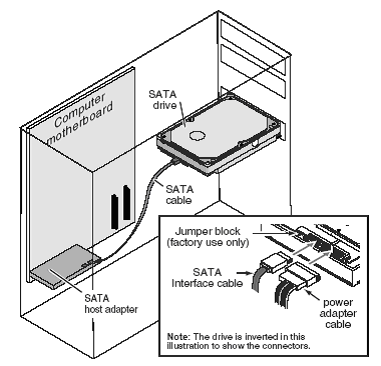I have a computer running Vista, with a single hard drive (multiple partitions, one with the operating system, the others for applications, data, etc.). I just bought a new computer, and am going to install Windows 7 on it.
I want to put the OLD drive in the new computer so I can just copy all my files and data over.
In the old days with the IDE drives… if memory serves… I’d have to mess with some jumpers so it’d know the OLD drive was no longer the master drive and to boot off the new Windows7 drive. Do I have to do anything fancy like that when I stick the old drive in the new computer so it knows not to boot off that drive, and to boot off the new Windows 7 drive? If so, what do I do?

Install Old SATA Boot Drive
IF your “old” HDD is a SATA unit, there are NO jumpers to adjust. (In fact, although some do have a jumper on them, you should NOT change it unless you know what you’re doing!) A SATA port only allows the connection of ONE unit to it, so there is no need to give its connected device some unique identity. Just plug the old HDD into any available SATA port, and connect power to it also. Just to be sure, when you reboot go into BIOS Setup and check that the HDD is showing up properly on the correct SATA port. Then check where the Boot Priority is set and make sure the old HDD is NOT one of the devices available as a boot device.
Now, IF your “old” HDD is an IDE unit that you must connect to an IDE port on the mobo, then you DO have to set its jumper correctly. ANY IDE port MUST have a Master device on it to be used, and MAY have a Slave device additionally. So if this old HDD is the ONLY drive on an IDE port, it MUST have its jumper set to Master (or to Master with no Slave present, if that is a different option). Then it should be plugged into the END connector on the ribbon cable for it. On the other hand, if this is an IDE HDD and you’re plugging it into an IDE port as the second device on the ribbon cable (on the middle connector), make sure its jumper is set to Slave. BUT in this latter case, IF the first device already on the cable has its jumper set to “CS” (for Cable Select), and not to Master, then the second drive on the cable also must be set to “CS”.
“Master” and “Slave” are settings of jumpers that are related solely to the drive’s function on one IDE port. There is no such thing as a “Master Drive” of the whole machine. You already have a Boot Drive in your machine, and you are just installing a second unit that will be used as a storage device, but NOT as a Boot Drive.

